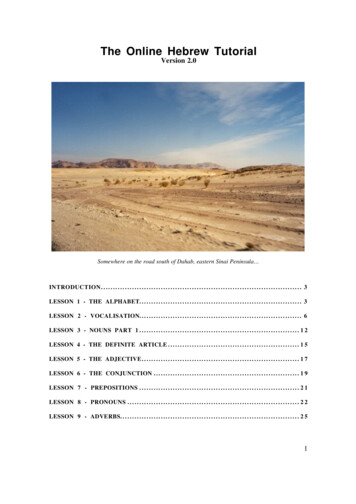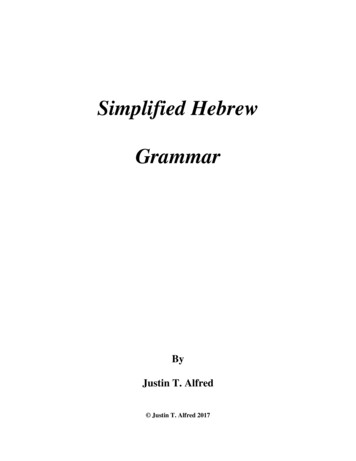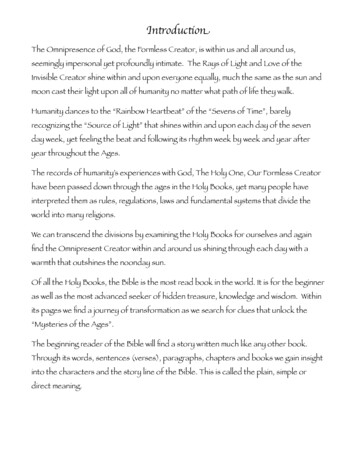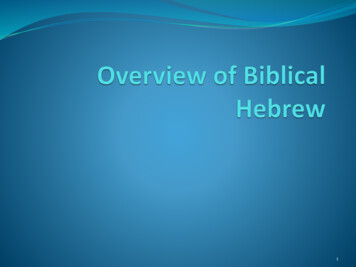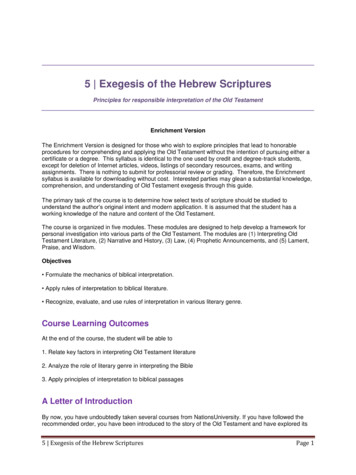
Transcription
for responsible interpretation of the Old Testament5 Exegesis of the Hebrew ScripturesPrinciples for responsible interpretation of the Old TestamentEnrichment VersionThe Enrichment Version is designed for those who wish to explore principles that lead to honorableprocedures for comprehending and applying the Old Testament without the intention of pursuing either acertificate or a degree. This syllabus is identical to the one used by credit and degree-track students,except for deletion of Internet articles, videos, listings of secondary resources, exams, and writingassignments. There is nothing to submit for professorial review or grading. Therefore, the Enrichmentsyllabus is available for downloading without cost. Interested parties may glean a substantial knowledge,comprehension, and understanding of Old Testament exegesis through this guide.The primary task of the course is to determine how select texts of scripture should be studied tounderstand the author’s original intent and modern application. It is assumed that the student has aworking knowledge of the nature and content of the Old Testament.The course is organized in five modules. These modules are designed to help develop a framework forpersonal investigation into various parts of the Old Testament. The modules are (1) Interpreting OldTestament Literature, (2) Narrative and History, (3) Law, (4) Prophetic Announcements, and (5) Lament,Praise, and Wisdom.Objectives Formulate the mechanics of biblical interpretation. Apply rules of interpretation to biblical literature. Recognize, evaluate, and use rules of interpretation in various literary genre.Course Learning OutcomesAt the end of the course, the student will be able to1. Relate key factors in interpreting Old Testament literature2. Analyze the role of literary genre in interpreting the Bible3. Apply principles of interpretation to biblical passagesA Letter of IntroductionBy now, you have undoubtedly taken several courses from NationsUniversity. If you have followed therecommended order, you have been introduced to the story of the Old Testament and have explored its5 Exegesis of the Hebrew ScripturesPage 1
theological meaning. You are now ready to consider how you can undertake your own independent studyof scripture and be reasonably sure you have understood it properly.This course, “Exegesis of the Hebrew Scriptures,” promises to offer some constructive guidelines for yourfuture study of the biblical text. Why, you ask, should I need “guidelines”? The answer is rather simple.Guidelines help avoid pitfalls that can lead to wrong interpretation. For example, when interpreting thePsalms, one sees two lines that look almost identical. The first inclination may be to think the author islaying down two separate thoughts. But by understanding something about the feature of parallelismwithin Hebrew poetry, you are more likely to perceive that the author is using different words to stress apoint. Again, one modern approach to prophetic literature may lead to the conclusion that all propheticliterature is predictive in nature. And, one might surmise that predictive prophecy always comes to pass inliterary terms. We shall explore the nature of prophetic literature from a biblical perspective. But we needto have some guidelines to keep us on track with interpretation.What you have learned in the past will not be lost in this course. Rather, you will find yourself being muchmore at home with the biblical text. And you will grow more certain of your footing as an interpreter of thesacred text. The object of higher education is not that we give you all the answers. The object is for you tobecome an able interpreter of the Word so you can grow in faith and can teach others much moreaccurately.The study is not exhausting. But it does require dedication.Procedure1. The syllabus has five modules. Review each module to see the layout of the course.2. Following your review, begin your work with Module 1. Read the syllabus carefully. Complete theactivity.3. As you come to the end of Module 1, review the material to make sure you have not missed anything.4. Once you have completed the exam over Module 1, move on to the other modules.Things to Know1. Terms: apocalyptic, exegesis, genre, hermeneutics, lament, praise, translation, wisdom2. The task of achieving good translation, exegesis, and hermeneutics—in that order3. The nature of scripture, covenant, ancient legal legislation, Hebrew poetry, and wisdom (proverbial)literature4. The goal of interpretation5. The components of narrative6. The nature and function of prophecy, including oracles of salvation and announcements of judgment7. The nature and function of apocalyptic, lament, praise, and wisdom8. Rules for interpreting apocalyptic, historical narrative, covenant legislation, and proverbial literature5 Exegesis of the Hebrew ScripturesPage 2
Copyright PolicyNationsUniversity , as a non-profit educational institution, is entitled by law to use materials protected bythe U.S. Copyright Act for online education. Any use of those materials outside this environment mayviolate the law.Exegesis of the Hebrew ScripturesOne person may pick up a Bible, start reading it, and declare that it does not make sense. Another mayread a passage haphazardly and make a personal application that has no resemblance to the inherentmeaning of the passage. Still another may shun certain biblical books, because they seem to be boring orfail to suggest relevancy. What do these responses imply? They imply a lack of understanding of thenature of the Hebrew Scriptures.Every person who opens a Bible is an "interpreter." Whether conscious of it or not, when one reads abiblical passage, one draws from it a certain conclusion. That conclusion may be driven by a prejudiceagainst a particular book or the Old Testament as a whole. It may be that one is looking for a piece ofinformation that will prove a point or satisfy a curiosity. Or, it could be that the person is doing someserious investigation. Regardless of the pre-condition that governs the reading, one is more likely toextract the correct interpretation and application if one understands linguistics and follows simpleguidelines.Since the modern student was not part of the "original" audience, a biblical text may appear remote.Interpretation may even appear irrelevant. Should one, therefore, conclude that the text is of no benefit tomodern people? If the Bible is taken to be God's book, it will have meaning for all persons. Yet, it doesnot follow that all portions of scripture issue "commands" to all people in all time periods.Assuming the Hebrew Scriptures have relevance, what is biblical interpretation about? The short answeris that interpretation is about knowing God. The value derived from interpreting the Old Testament can bemeasured in terms of personal spiritual enlightenment. If value to Old Testament study is to result, then itfollows that correct interpretation is requisite to application.This course carries the word "exegesis" in its title, for this is where the primary interest lies. "Exegesis"comes from the Greek and means to "draw out." It has become a technical term for comprehending atext within its original setting. In this instance, exegesis is a discipline that draws out the inherentmeaning of a particular biblical text. However, to limit the course to strict exegesis would beshortsighted. Consequently, we are obliged to use several terms in our effort to convey the idea of whatsometimes appears as a three-phase process: (1) drawing out the meaning inherent within the passage,(2) determining the meaning of that passage, especially in view of its implementations, and (3) applicationfor modern audiences.Because not everyone assigns the same meaning to the terms, we will makes some arbitrarydistinctions. As an extension of technical "exegesis," the term "hermeneutics" has come into play todenote the use of methodological principles that extend the basic idea of strict exegesis. In other words,hermeneutics often includes both meaning and application. For analysis sake, we may limit exegesis bythe question, "What does the text say?" Hermeneutics then would be concerned with this question:"What is the extended meaning of the text and how is this meaning to be applied?"Other terms may be used in a general sense, such as interpretation and exposition. When used, theysimply represent an act of explaining, uncovering, revealing, or displaying. The term application will beused to suggest how the meaning of a passage is to be used. The choice of this term suggests a specific5 Exegesis of the Hebrew ScripturesPage 3
demand that the meaning of a passage makes.The definition of terms may be straightforward, but stock definitions do not determine interpretation. Ifone presupposes a literary text (in our case, a biblical text) has an inherent meaning, and comprehendingthat meaning is essential to proper interpretation, then exegesis plays an essential role. But if onepresupposes otherwise, then the importance of exegesis is diminished. Further, if a passage isconnected with a desired action, then the full three-phrase process is not achieved until the action isundertaken.You should be aware of three different assumptions that people make about interpreting the Bible.1. Some assume that the actual intent of the author should govern the understanding of any givenbiblical text.2. Others assume that an external force--be that a church, organization, or society--assigns meaning to agiven biblical text.3. Still others assume that the individual reader can give meaning to a biblical text as he/she experiencesit.It is conceivable that all three of these can be in agreement--author, tradition, and reader--but more oftenthan not, different assumptions will yield different conclusions.This course rests on assumption 1 above. This means that the control for interpretation is the author'soriginal intent, not an outside organization, and not a modern person's experiential response to areading. A premium is placed on the type of exegesis that seeks original intent, even when authorialintent may not always be visible. When they offer a fuller or extended meaning to Old Testamentpassages, New Testament writers do not violate the assumption.Exegesis presumes justice is done to a text without speculation. It begins with finding the meaning--themeaning for the original readers to the extent possible. This may require the use of archaeological finds,ancient documents outside the Bible, and other materials that can shed light on the context. But thefocus is on grammar, genre, and vocabulary.The course is organized in five modules: (1) Interpreting Old Testament Literature, (2) Narrative andHistory, (3) Law, (4) Prophetic Announcements, and (5) Lament, Praise, and Wisdom. These modules aredesigned to help you develop a framework for your own investigation of various parts of the Old and NewTestaments. Module 1 examines the need to interpret the Old Testament and the basic theory that liesbehind interpretation. The ultimate quest is to be able to do your own study and learn how to handle theScriptures properly so you can make appropriate application.MODULE1 Interpreting Old Testament Literature"Interpretation" is a common term that connotes the idea that something has been explained. To interpretis to understand what something means. As already noted, interpretation includes exegesis and theextended meaning of a text.Exegesis involves technical literary skills. Interpretation uses these skills to determine what should bedone with a passage. For example, exegesis of Prov. 11:1 is simple: "The LORD abhors dishonest scales,but accurate weights are his delight." The setting, of course, is a time when ancient scales could beeasily manipulated to short-weigh agricultural products. The inherent meaning of the passage is thatdishonesty (the lack of integrity) is against Yahweh's nature. He is pleased with honest trading. And thisis a fair interpretation of the proverb. Yet, the larger question is, Does the principle found in the proverb5 Exegesis of the Hebrew ScripturesPage 4
apply only to weights? What about measurements, promises, and other dishonest actions? Whatapplications may be made of this proverb in modern life? Or, better yet, What implications does theproverb have for Christians?Another example may be found in Mal. 3:8, where a careless Jewish community is charged withwithholding proper sacrifices. The accusation begins with a question: "'Will a man rob God?' Yet you robme. But you ask, 'How do we rob you?' In tithes and offerings." The exegete may begin with thesacrificial system and may observe the rabbinic form employed by the 5th century prophet. The largercontext may indicate the nature of the failure in offering sick animals. Surely, the present communityneeded to rectify the situation, but how would future Jews profit from the condemnation? Whatimplication does the passage have in light of the end of the sacrificial system and the establishment of theNew Covenant where tithing is replaced by purposed giving?Some passages pose difficult exegesis but may have a clear application. In Gen. 6:4, the text states,"The Nephilim were on the earth in those days--and also afterward--when the sons of God went to thedaughters of men and had children with them." Two features are bothersome in this passage. One hasto do with the identity of the Nephilim. The second pertains to the identity of "the sons of God." But theimplication is that marriages that mix good and evil elements tend toward corruption. In exegesis thepassage is descriptive of a past activity and is preliminary to explaining the story of the Flood. Yet, itsupports a principle. And beyond the principle, it testifies to the judgments of God against evil.In pursuing interpretation of the Old Testament, an important issue must be raised that will affectinterpretation of Old Testament literature. It is the same issue that modern nation states face wheninterpreting their constitutions. If the constitution was written in a time when circumstances were differentfrom the way they are today, a question of its continuing legitimacy may be posed. If so, several optionsare open: (1) continue to apply it literally, (2) discard it and replace it with a new one, (3) revise it, (4)amend it, (5) ignore it, or (6) treat it as a “living” document. Sometimes, a government may apply morethan one choice, such as amending the constitution and treating it as a living document or giving lipservice to it but ignoring unattractive stipulations. To illustrate how the options work, a constitution thatdoes not allow women to vote may be amended to allow women’s suffrage.If a national constitution is held to be a “living” document that can be adjusted to modern times, thenrulings that go beyond (or come short) of the intent of the framers of the constitution can beenforced. This is commonly done through court rulings on issues involving human rights and freedoms.We can understand the need for human documents to be “reinterpreted” to fit the times. However, can thesame rules be applied to the Bible? To do so is to admit that the Bible is outdated and that humans havethe right to change, ignore, revise, or treat it as a “living” document. If, on the other hand, the Bible is ofdivine origin, the issue is not the same. For example, who has the right to change the injunction regardingadultery and fornication?When interpreting the Old Testament, still another issue faces us. For the Jew, oral law may become theofficial interpretation of the written law. For the Christian, the Old Testament is not “binding,” as itrepresents the “old” covenant that has been “nailed to the cross.” How, then, does the Christian treat theOld Testament? Is it useless, instructional, or what? We shall examine these issues as we proceed withour study.The module is broken into three parts. These are Unit 1 The Need to Interpret the Bible, Unit 2 The Taskof Interpretation, and Unit 3 Interpreting the Old Testament in Translation.Unit 1. The Need to Interpret the BibleTo some, the Bible needs no interpretation. It simply needs to be read! Others hold that its message is soshrouded in mystery that only specially endowed people can understand it. Perhaps the more balancedapproach lies somewhere in between. The general message of the Scriptures can be understood byeveryone, yet greater comprehension requires more than casual reading.5 Exegesis of the Hebrew ScripturesPage 5
Passages of scripture often generate discussion and debate, not over what the text says, but over whatthe text means. Such disagreements suggest that the critical issue in biblical study in not front-endexegesis, i.e., identifying literary genre, vocabulary, and grammatical construction. The crucial matter isunderstanding what the author meant when he chose specific genre, vocabulary, and construction. Afterthis comes the quest for how the passage may find legitimate standing for a modernaudience. The need to interpret the Bible rises from an urgency to discover "truth" that may beg forapplication in current circumstances.The intended meaning of a text may become obscured if the reader does not observe proper rules orguidelines. One may be careless and simply overlook the obvious meaning. One can read a personalinterpretation into the text and miss the inherent meaning. We need to learn how to interpret the Bibleaccurately so many of the ignorant disputes will disappear.As a foundation on which sound interpretation may be achieved, the discussion in this unit addressesthree topics. These are (a) The nature of scripture, (b) The scope of interpretation, and (c) Theinterpreter. As you work through the unit, two questions should be kept in mind. How can one be surethat the biblical text is handled properly? How can one be certain of the meaning of what one reads? Webelieve these questions are reasonable. You should not be threatened by either of them.If the Bible is of God, it must be both true and relevant. If it is relevant, it's content should impact one'slife. The optimum goal of interpretation is, therefore, to touch lives in such a manner as to change, modify,encourage, confirm, or correct them in keeping with the will of God. Therefore, everyone needs todiscover the message of the Bible.a. The nature of scripture. Inasmuch as “scripture” is considered sacred, reading the Old Testamentshould be undertaken with a sense of awe. Its message is uniquely God-breathed. At the same time, theBible is a written document that begs to be heard in its setting. It is a literary piece that employs a varietyof literary forms. Since the Bible is written in human language, it is to be interpreted in keeping withwriting techniques common at the time of composition. Yet, the Bible is not mere history or biography orshort story or wisdom or poetry. It intends to impact the life of every contemporary reader spiritually. Onereads, studies, and interprets in order to know God.The Scriptures are the product of over a millennium of writing activity. They were shaped by a variety ofwriters and styles. Together, the books of the Bible comprise a single entity. There is remarkableconsistency in the Bible in terms of its themes and ideas. Consequently, one should not read in anattempt to find contradictions but with a view toward spiritual enlightenment.If one begins with humanistic assumptions, then one will regard the Bible as the product of imperfect menwho are trying to explain their place on earth. On the other hand, if one begins with God, whoserevelation of himself is found in the Bible, the perspective will be much different. The former makes manthe ultimate source of understanding; the latter looks to God for meaning.For the believer, the Hebrew Scriptures tell God's story. When approaching this body of literature fromthat perspective, individual pieces become parts of a living organism. None of the compositions are coldancient history or antiquated legal codes. They have vibrancy about them and contain treasures of divinewisdom.The Bible is written in two basic literary forms: narrative and poetry. We shall say more about narrative inModule 2. Let us mention here a most prominent feature about poetry--the use of parallel lines. Ratherthan use rhyme to set lines in parallel, the Hebrews made their lines synonymous or continuous. Psalm8:4 provides a good example of synonymous lines, where "what is man that you are mindful of him" isfollowed by "the son of man that you care for him." Man and son of man are equal. Both terms identifythe human being as the object. Being mindful of him and caring for him mean the same thing. Thearrangement is simply to emphasize God's attitude toward his creation.In Psalm 8:3 parallel lines are continuous. That is, the thought of the first line is continued in thesecond. The author begins with, "When I consider your heavens" and continues with the idea that they5 Exegesis of the Hebrew ScripturesPage 6
are "the work of your fingers." The second line points back to the first. In lines three and four, theauthor connects with the thought by noting "the moon and the stars" as the prominent features of "yourheavens"--hence the two ideas run in parallel. These heavenly objects, "you have set in place" becomesparallel to "the work of your fingers." So, lines one and two and lines three and four complement eachother. But lines one and three also complement one another as do lines two and four.As you become familiar with the routine of parallel writing, you will be able to appreciate the morecomplex formulations found within Hebrew poetry. Recognizing parallelism is essential to interpretation.Some psalms are built as an acrostic. The most remarkable one is Psalm 119. Here, every eight versesbegin with a different letter of the Hebrew alphabet--in sequence. The first eight verses begin with theinitial letter of the alphabet--the letter Aleph. In translation, this is not evident, as the feature is impossibleto capture in the receptor language. Words in translation simply do not begin with the same letter.b. The scope of interpretation. The Hebrew Scriptures are a composite of literary works produced inancient Israelite culture intended primarily for ancient Israelite people. For modern people to comprehendthe message of these writings, they must bring them into a language of their own comprehension. Theywill need to understand the circumstances surrounding these writings. They must also ask about therelevance of the message of these books to modern life.The Hebrews from Moses' time forward lived under the regulations of the Law of Moses. This being thecase, we will understandably question the applicability of biblical literature to a non-Jewish audience.However, to label the books of the Old Testament as ancient history of the Jewish people and proceed totreat the corpus as something which has no relevance for today discounts its value and renders its studynearly useless. It also overlooks the true nature of the literature itself.The interpretative process can involve the whole text or a portion thereof. A pericope (a short passage oftext within a larger text) should be harmonious with the text as a whole. An exception may be a cited textthat bears no relationship with the entire body of Scripture. Herein, one faces a primary question. Arebiblical references related to the whole of a particular composition or is the biblical text disjointed? If oneassumes that a biblical book is a unified whole and that its constituent parts comprise meaningfulelements of the whole, then it follows that interpretation of the various parts must be done within theframework of the whole. In the case of quotations from outside sources, the original quote will have itsown context and the biblical author may be using it to support his own goals. In this case, there may bean original interpretation and a secondary interpretation that fit the biblical author's purpose. In the case ofthe Psalter and the Book of Proverbs, individual psalms or proverbs are much more loosely related thanare narratives that appear in other biblical books. So, one may need to analyze carefully the wording ofindividual psalms or proverbs when relating them to the whole corpus.Determining what application should be made for the present day defines a secondary task of the course.The endeavor recognizes three audiences in the interpretative process: (1) an original audience, (2) asecondary audience, and (3) a present-day audience. The original audience would have been the peopleto whom an oracle, law, or statement was first directed, often in oral form. The secondary audience wouldbe the people to whom a biblical composition was directed in written form. The present-day audienceincludes the contemporary reader. In all events, the literary genre of the written composition must betaken into account, whether the genre be narrative, poetry, legal, apocalyptic, praise, wisdom, or someother. Additionally, background material, linguistics, contexts, and hermeneutical principles will play animportant role in determining the proper meaning of a biblical text for all audiences addressed.c. The interpreter. When one reads the Bible in a language other than its original language, one isreading the "interpretation" made by others. Scholars wrestle with which word to use to translate theoriginal Hebrew. Since languages differ in vocabulary and syntax, scholars make an educated guessabout which word to use to translate a particular Hebrew word. They also must decide whether to beconsistent when the vocabulary in the new language offers more specific nuances. So, in a sense,"interpretation" has already taken place before the reader has an opportunity to read the text.Beyond the translator, every reader of the Scriptures is an "interpreter," for the reader must make senseof the words of the text. What do the words mean when they are called individually? What do the words5 Exegesis of the Hebrew ScripturesPage 7
mean when placed in relationship in a sentence or paragraph? The reader will tend to filter the textthrough his/her own understanding of the vocabulary. Common usage of a language often conveysnuances to words that were not there when the text was first translated.The way one goes about interpreting the text is influenced by personal experiences, cultural outlooks, andlinguistic perceptions. Or a passage may trigger in the reader's mind some idea that is actually foreign tothe text. Again, the reader's understanding of the meaning of a particular word may suggest somethingother than what the author intended to convey. There is also risk of accepting a popularizedinterpretation without examining the text itself.Because one sometimes hears what one wants to hear, the true message may go undetected. Forexample, the word "sacrifice" may bring to mind the killing of an animal and placing it on an altar. If thereader elects to push the act out of mind because it appears repulsive, he/she may fail to see thesignificance of the sacrifice. Interpretation is concerned with more than word identification; it is concernedwith contextual meaning. Yahweh's command to Abraham to offer his son in sacrifice is hardly somethingthat one would take personally or even condone for today. The meaning is clear for Abraham, and itsapplication is limited to one specific person. Interpretation in this instance has more to do with Abraham'sfaith than with understanding the particulars of the incident.Every person or group who claims to follow the Bible will base beliefs and practices onscripture. Nonetheless, aberrations may result from poor interpretations. This happens when passagesare taken out of context or are simply misunderstood. Another thing that can happen is that one mayclaim a private revelation or insight and pass it along as God-given. This is why rules become necessaryto govern interpretation. Such rules must preserve the integrity of the biblical text and supportinterpretations that are in harmony with the Bible in general.Unit 2. The Task of InterpretationConsidering the antiquity of the Bible and the variation found in its literary formation, the task ofinterpretation appears to be a formidable one. Yes, indeed, the book is large, covers a long period oftime, and embraces many topics. Furthermore, if the Old Testament is taken to be "sacred," it should betreated with respect. Its message is precious. It begs for careful effort at understanding.The text of the Old Testament is written primarily in Hebrew, with a few sections in the more widely usedAramaic language. Standard Hebrew genre, idioms, and vocabulary characterize the entire composition.This means (1) that the text reflects the language that was standard at the time and understood by thecommoner and (2) the authors used the full range of literary genre characteristic of ancient Hebrew.Consequently, interpreting the Old Testament must be done in keeping with the forms of the ancientHebrew language.To arrive at the proper meaning of Old Testament texts for today, one is obliged to seek first correct"exegesis." That is, one will consistently ask, What did it mean in its original setting? Then one should besensitive to New Testament insights. New Testament writers often quote the Hebrew text or theSeptuagint (Greek translation). They sometimes extend the meaning of those texts. Here is where theinterpreter must observe closely the purpose of the quotations. Please consider two precautions.One, you may be tempted to interpret an Old Testament passage in light of the New Testament when theNew Testament never makes a specific connection. To illustrate, observe that Gen. 3:15 mentions theenmity between Satan and Eve's offspring: "He will crush your head, and you will strike his heel."Traditionally, this verse is taken to predict Jesus' defeat of Satan, yet the New Testament ne
Mar 05, 2019 · 1. Relate key factors in interpreting Old Testament literature 2. Analyze the role of literary genre in interpreting the Bible 3. Apply principles of interpretation to biblical passages A Letter of Introduction By now, you have undoubtedly taken several



